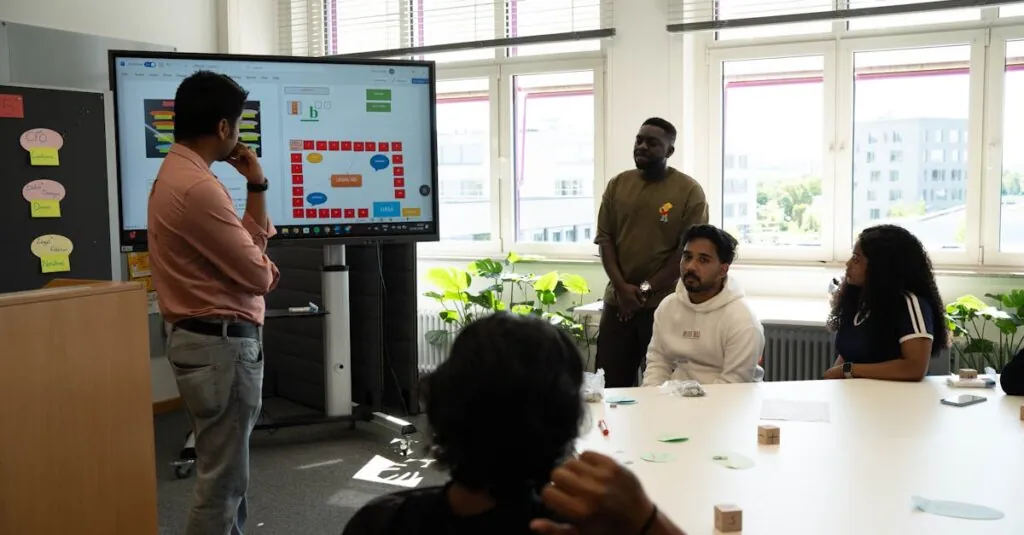In a world where the average person can binge-watch an entire season of their favorite show in one weekend, it’s shocking how many voters still don’t know the basics of the electoral process. Imagine showing up at the polls and thinking “What do I do now?” It’s like arriving at a party without knowing it’s a costume theme. A solid voter education strategy can transform confusion into confidence, ensuring everyone knows how to navigate the voting landscape.
Understanding Voter Education Strategy
Voter education is crucial for empowering individuals to engage effectively in the electoral process. A comprehensive strategy enhances political participation and ensures informed decision-making.
Importance of Voter Education
Voter education builds awareness about the electoral process. Understanding registration procedures fosters participation. Informed voters make choices that reflect their values and priorities. Research indicates that educated voters are more likely to cast ballots. Engagement through knowledge also enhances accountability among elected officials. Without such education, individuals may feel overwhelmed or skeptical about their power in elections.
Key Components of a Voter Education Strategy
A successful voter education strategy includes several essential components. First, outreach programs inform citizens about registration deadlines and polling locations. Second, incorporating workshops can provide details about candidate platforms and issues on the ballot. Third, leveraging social media effectively reaches younger voters. Additionally, partnerships with community organizations increase engagement. Lastly, providing multilingual resources ensures accessibility for diverse populations. Each component plays a significant role in fostering informed electorates.
Best Practices in Voter Education
Effective voter education demands a strategic approach. Engaging the community and utilizing technology stands out as critical components.
Community Engagement
Community engagement fosters personal connections among citizens. Local organizations can effectively conduct outreach programs that inform residents about registration and polling locations. Workshops allow for interactive discussions, making candidates’ platforms relatable. Identifying diverse communities encourages tailored educational initiatives. Collaboration with schools can enhance knowledge among younger voters and instill civic responsibility. Active participation creates a more informed electorate.
Utilizing Technology
Utilizing technology enhances voter education accessibility. Social media platforms are powerful tools for reaching younger audiences quickly. Short videos and infographics effectively convey vital information in an engaging format. Mobile applications can remind voters of important dates and deadlines. Websites must feature user-friendly resources for registration and polling information. Implementing virtual town hall meetings allows for real-time information sharing and Q&A sessions, fostering transparency.
Challenges in Implementing Voter Education Strategies
Voter education strategies face significant hurdles, impacting their effectiveness. Misinformation and disinformation pose a serious threat to informed voter participation.
Misinformation and Disinformation
Misinformation spreads rapidly through social media platforms and less reputable online sources, creating confusion among voters. Misleading claims about registration processes, polling locations, and candidate positions can distort public understanding. Disinformation campaigns, often funded by external entities, intentionally manipulate facts to influence voter behavior negatively. Such tactics undermine trust in the electoral process. Individuals often share information without verifying its accuracy, compounding the problem. To counter these challenges, educational campaigns must focus on providing accurate, fact-checked resources that empower voters to discern truth from falsehoods.
Accessibility Issues
Accessibility issues further complicate the implementation of effective voter education strategies. Language barriers limit understanding for non-English speakers, while limited internet access hinders information dissemination for many. Geographic disparities mean that rural voters might lack access to crucial educational resources compared to those in urban areas. Physical mobility challenges prevent some individuals from attending educational workshops or events. Creating multilingual materials and utilizing various outreach methods can bridge these gaps. Offering educational content through community organizations, libraries, and local media can enhance accessibility for all voters.
Successful Case Studies
Numerous successful voter education initiatives showcase effective strategies that can enhance democratic participation.
Local Initiatives
Community-based programs often lead voter education efforts in local districts. Projects like “Vote Smart” engage volunteers to host information sessions in neighborhoods, covering registration and polling details. These grassroots initiatives usually employ door-to-door canvassing along with small group meetings to spread awareness. Collaboration with local libraries and community centers amplifies outreach. For example, the Chicago-based organization “LEARN” provided bilingual workshops that significantly increased voter registration among Hispanic residents. The program helped 1,000 new voters register before the last election cycle.
National Campaigns
National campaigns leverage digital platforms to educate voters on a broad scale. Initiatives like “Vote.org” utilize social media channels and targeted advertisements to share essential election information. Statistics show campaigns like these raised voter turnout by 5% in 2020. Efforts by the “League of Women Voters” included sending out nonpartisan voter guides through online tools, helping millions learn about candidates and issues. Their national outreach, combined with local partnerships, maximized impact across demographics. These campaigns highlight the importance of clarity and accessibility in voter education.
A robust voter education strategy is essential for fostering an engaged and informed electorate. By implementing tailored outreach efforts and leveraging technology, communities can effectively combat misinformation and ensure that all voters have access to accurate information.
The success of these initiatives not only enhances political participation but also strengthens democracy itself. As individuals become more knowledgeable about the electoral process, they’re more likely to exercise their right to vote confidently.
Investing in voter education is crucial for building a future where every voice is heard and every vote counts.





